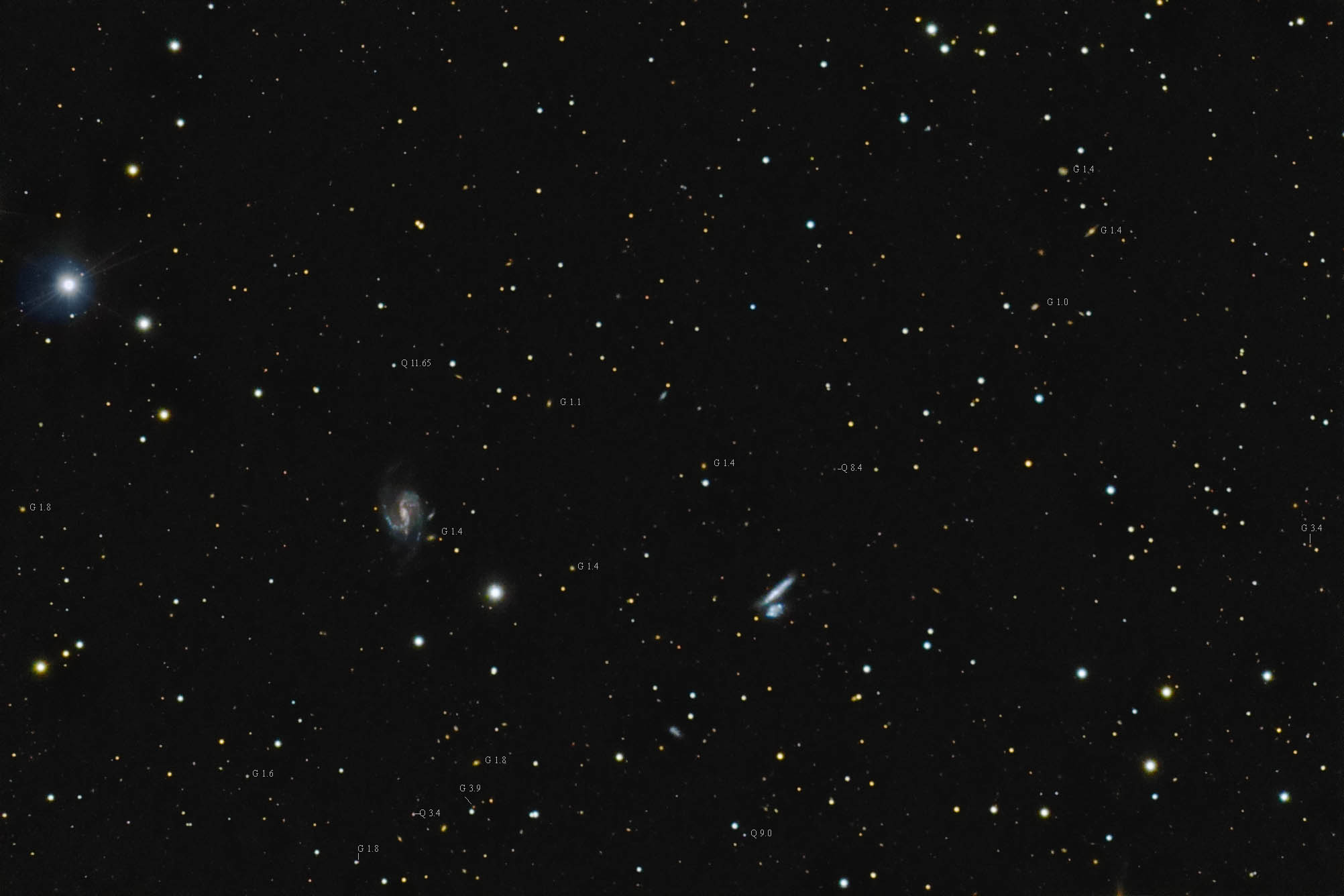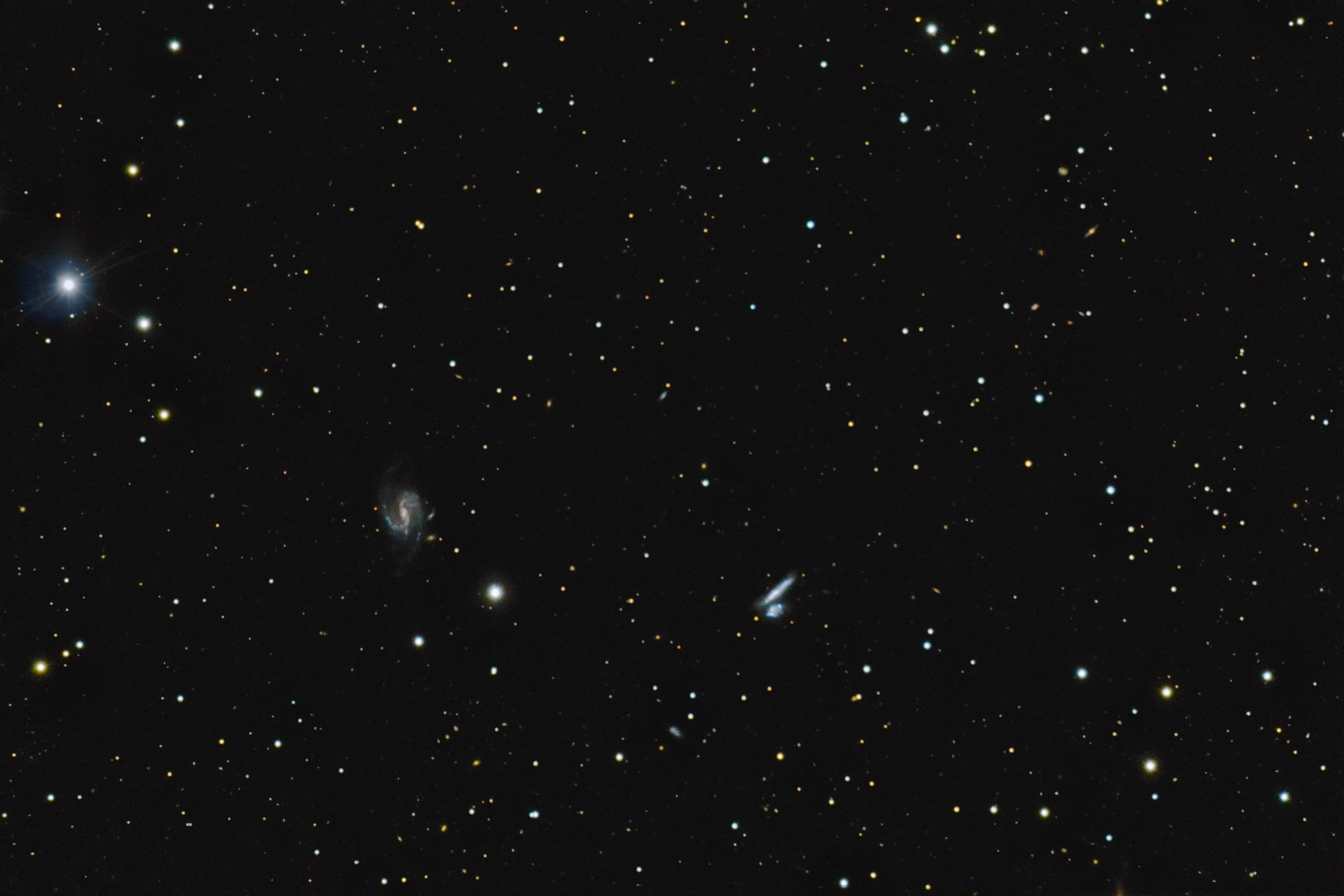Object name: ARP202Designation(s): ARP202, NGC2719, NGC2719A, NGC2724, Arp 202 is a pair of interacting galaxies about 150 million light-years from us in southern Lynx. Arp classed them under Galaxies not classifiable as E or S; Material ejected from nuclei. I'm not sure what "material" he is referring to. He comments; "Faint tail from small galaxy". I don't know if this refers to the faint fuzz at the west end of it or the three objects that trail to the west. The first is just a star, at least it isn't in the SDSS. The other two are separate galaxies per the SDSS though no redshift is provided. To me, they appear far distant galaxies though the Kanipe-Webb book considers this the tail. I see no difference between these two and a third galaxy directly below the eastern (middle of the three objects) galaxy. Arp became obsessed with the idea of galaxies ejecting objects and it appears his opinion of this pair may have colored by this concept. A note at NED says; "Faint fragments to east of smaller object." Seems no one really knows what Arp was referring to.
Arp 202 is composed of two galaxies NGC 2719 and 2719A. Both are classed as Im pec. The third major galaxy in the image is the nice two arm spiral, NGC 2724, SAB(s)c, with a redshift that puts it about 5 million light-years further away than Arp 202. Such a difference is immaterial so it is considered a member of the same group as Arp 202. There are two small galaxies to its right. The red one has a redshift indicating a distance of a bit over 1.4 billion light-years. Oddly, the blue spiral above it isn't in the NED SDSS database. It has hundreds of far fainter galaxies in this field but not this rather bright one. Nor could I find any entry for it at NED or SIMBAD.
The small elongated almost double looking galaxy SE of Arp 202 is SDSS J090028.22+354009.8, also a member of the Arp 202 system. The blue spindle galaxy NE of Arp 202 is SDSS J090029.38+354840.6 and is also a member of the Arp 202 group. Halfway between Arp 202 and the last galaxy is a very orange galaxy just above a brighter blue star. This galaxy is SDSS J090029.38+354840.6 and is about 1.4 billion light-years distant.
In keeping with the trend that blue is a member of the Arp 202 group and red isn't we come to SDSS J090043.64+354829.0 directly east of the blue spindle. It is 1.1 billion light-years away. The relatively large red spindle NW of Arp 202 is SDSS J085935.91+355242.6 and it is almost 1.4 billion light-years from us as is SDSS J085939.37+355413.7, the round red galaxy to its northeast. The spindle galaxy is very unsymmetrical with a far fatter and brighter disk to the SE than to the NW of the core. I wonder what caused that. Is the disk warped so we see it more face on to the SE or is it really less massive to the NW? Between the spindle at 1.1 billion light-years and Arp 202, much nearer the former is another rather bright reddish galaxy. It is SDSS J085943.03+355048.9 at a bit under 1 billion light-years.
I've made an annotated image with the distances in billions of light-years noted. Several other galaxies and a quasar are in the image that are also noted on this image beside these I've mentioned. The interesting thing is that one of the galaxies is actually more distant, not by much, than one of the quasars in the image. Both are over 3 billion light years distant. But the quasar at 8.4 billion light years is a lot further away. Of course, Arp likely wouldn't agree and might say they were emitted by Arp 202 rather recently. The most distant quasar in the image is also the brightest. This Arp would jump on instantly. Its redshift puts it at 11.65 billion light-years away. The photons I captured have traveled more than twice the age of our solar system and possibly longer than our galaxy even existed. In fact, the light left when the universe was only about 2 billion years old. It boggles the mind to think about.
One of the distant galaxies I've noted but not mentioned yet is SDSS J090107.85+353657.1 at 1.8 billion light-years near the bottom of the image. It is a 22nd magnitude galaxy hiding behind a much brighter star. You may have to enlarge the image to see that there are two objects there. The galaxy is sticking out of the western side of the star. Nearby to the NW is SDSS J090121.47+353908.0 at 1.6 billion light years that appears to be a blue star. But the magnitude and position exactly match a galaxy in the SDSS so I assume it is correct. Also, the PSF (how the light varies across the object) is typical of a galaxy and very atypical of the known stars in this part of the image. So appearances can be deceiving.
NGC 2719 was discovered on March 28, 1786 by William Herschel. It isn't in either of the Herschel 400 observing programs. NGC 2724 was found by his son John Herschel on February 7, 1832.
Arp's image is at: http://nedwww.ipac.caltech.edu/level5/Arp/Figures/big_arp202.jpeg
The Sloan Digital Sky Survey image of Arp 202 is at:
http://astronomerica.awardspace.com/SDSS-18/NGC2719.php
The SDSS image for NGC 2724:
http://astronomerica.awardspace.com/SDSS-18/NGC2724.php
Their filters don't show the color difference between the two galaxies on its western side that my image shows. They use a different mix of filters that does alter the color balance from what the eye would see if it could see such faint color. This helps greatly in their scientific analysis but does make for sometimes misleading images. Other times the color is reasonably correct. I've not determined why the variation.
14" LX200R @ f/10, L=4x10' RGB=2x10'x3, STL-11000XM, Paramount ME Related Designation(s):2MASS J09001547+3543405, 2MASS J09010181+3545419, 2MASS J09010181+3545435, 2MASX J09001576+3543387, 2MASX J09001609+3543077, 2MASX J09010184+3545431, 2MASXi J0900157+354338, 2MASXi J0900160+354307, 2MASXi J0901017+354542, 2MFGC 07030, ARP 202, ARP 202 NED01, ARP 202 NED02, ARP202, CG 0234, CG 0235, CGCG 0857.1+3555, CGCG 0857.1+3555 NED01, CGCG 0857.1+3555 NED02, CGCG 0857.8+3557, CGCG 180-025, CGCG 180-025 NED01, CGCG 180-025 NED02, CGCG 180-027, ECO 05213, ECO 09846, ECO 10722, FIRST J090015.5+354339, FIRST J090016.0+354307, GALEXMSC J090015.86+354313.0 , GALEXMSC J090101.68+354540.4 , HOLM 105, HOLM 105A, HOLM 105B, IRAS 08571+3555, IRAS F08571+3555, IRAS F08579+3557, KPG 181, KPG 181A, KPG 181B, KUG 0857+359A, KUG 0857+359B, KUG 0857+359C, LCSB L0360O, LCSB L0361O, MCG +06-20-017, MCG +06-20-018, MCG +06-20-019, NGC 2719, NGC 2719A, NGC 2724, NGC2719, NGC2719A, NGC2724, NSA 135610, NSA 156983, NVSS J090015+354328, PGC 025281, PGC 025284, PGC 025331, SDSS J090101.77+354544.8, SSTSL2 J090015.55+354329.1, UGC 04718, UGC 04718 NOTES01, UGC 04726, UZC J090015.6+354340, UZC J090101.8+354545, [TCW2007] 056, [WGB2006] 085706+35550_a, [WGB2006] 085706+35550_b, | | 
